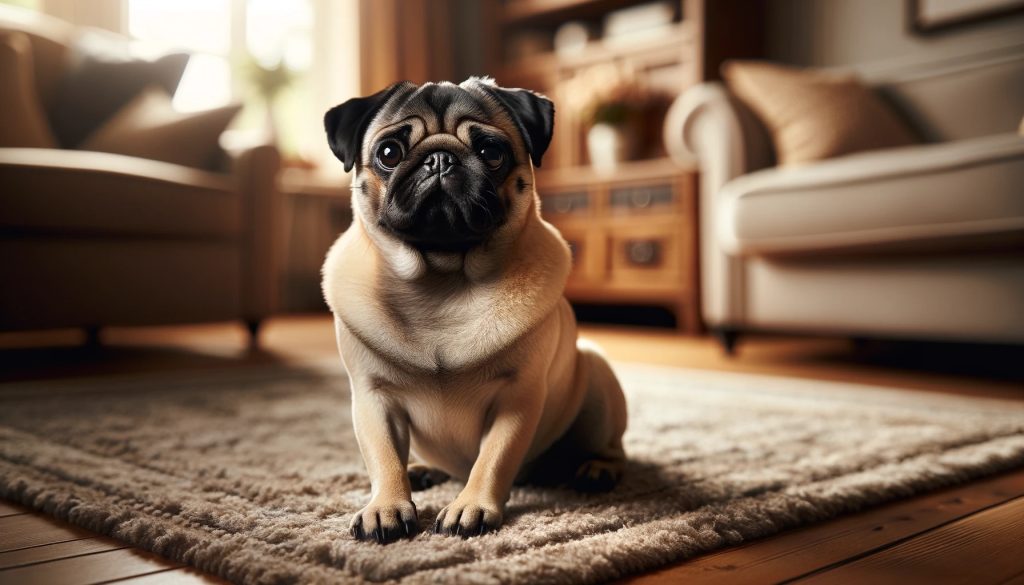
Understanding the Pug
Sociability and Companionship
Pugs are known for their sociable and affectionate nature. They thrive on human companionship and are rarely happy when left alone for extended periods. These dogs form strong bonds with their owners and often suffer from separation anxiety if left alone too long. Pugs are definitely not the breed for those who spend long hours away from home.
Affectionate by Nature
Cuddling is one of a pug’s favorite activities. They love to be close to their owners, often following them around the house. Pugs are lap dogs; they enjoy snuggling up next to their human companions during downtime. This breed’s affectionate nature makes them great pets for families and individuals seeking a loving companion.
Vocalization
Pugs do bark, but not excessively. They are likely to bark when they want attention or when someone is at the door. However, their barking is generally not as loud or as frequent as some other breeds. Proper training and socialization from a young age can help manage their barking behavior.
Emotional Sensitivity
Pugs are emotionally sensitive dogs. They can get their feelings hurt if scolded too harshly or ignored. They respond best to positive reinforcement training methods. Harsh treatment can lead to behavioral issues in pugs. It’s important to be gentle and understanding with this breed.
Exercise Requirements
Despite their small size, pugs need a fair amount of exercise. A daily walk and playtime are essential for keeping them healthy and preventing obesity, a common problem in pugs. However, due to their brachycephalic (short-faced) nature, they should not be over-exercised, especially in hot or humid weather, as they can have breathing difficulties.
Health Considerations
Pugs, like many purebred dogs, are prone to certain health issues. Their distinctive facial structure can lead to breathing difficulties, particularly in hot or humid weather. Owners should be aware of this and avoid strenuous exercise during these conditions. Regular veterinary check-ups are essential to monitor and address any health concerns early on.
Dietary Needs
Due to their propensity for obesity, pugs require a well-balanced diet. Portion control and avoidance of excessive treats are crucial. High-quality dog food that meets their nutritional needs without adding unnecessary calories is recommended. Keeping them active and maintaining a consistent feeding schedule helps manage their weight.
Grooming and Care
Pugs have a short coat, but they shed quite a bit. Regular brushing will help manage the shedding and keep their coat healthy. They also have distinctive facial wrinkles that need to be cleaned regularly to prevent infections or irritations. Nail trimming and dental care are also important aspects of their grooming routine.
Training and Socialization
Pugs are intelligent and can be trained with patience and positive reinforcement. They respond well to reward-based training methods. Early socialization is important to ensure that they grow up to be well-rounded dogs. Exposure to different people, pets, and environments can help them become more adaptable and less anxious in new situations.
Family Integration
Pugs are excellent family pets. They generally get along well with children and other animals, making them a great addition to most households. Their small size and adaptable nature make them suitable for both apartments and houses. They thrive on human interaction and are happiest when they are part of family activities.
Pug Dog Breed: Overview Table
| Aspect | Detail |
|---|---|
| Average Lifespan | 12 – 15 years |
| Temperament | Sociable, Affectionate, Playful |
| Exercise Needs | Moderate; daily walks and play sessions |
| Health Risks | Prone to obesity, breathing issues, eye problems |
| Grooming Needs | Regular brushing, frequent cleaning of facial wrinkles |
| Ideal Living Conditions | Does well in apartments and houses, needs human companionship |
| Trainability | Responds well to gentle, positive training methods |
| Socialization | Enjoys human interaction, good with children and other pets |
| Vocalization | Moderate barking, not overly noisy |
| Emotional Sensitivity | High; sensitive to owner’s mood and tone |
This table provides a snapshot of what it’s like to have a pug as a pet. Their charming personality and loving nature make them a delightful addition to any family. Their needs and characteristics should be considered to ensure they lead a happy and healthy life.
Conclusion
The Pug breed, with its charming personality and affectionate nature, makes for a wonderful companion. They fit well into various types of households, from singles to families with children. However, prospective owners should be mindful of their specific needs, including health considerations, exercise requirements, and grooming needs. With proper care, a Pug can be a delightful and loving member of any family, offering years of companionship and joy.
